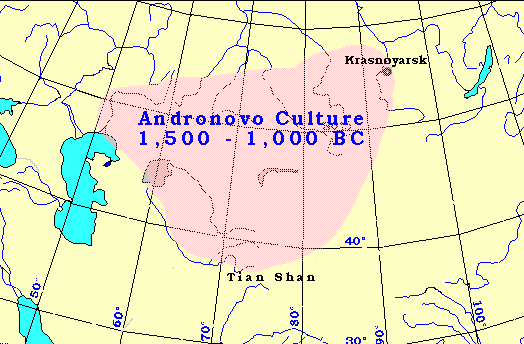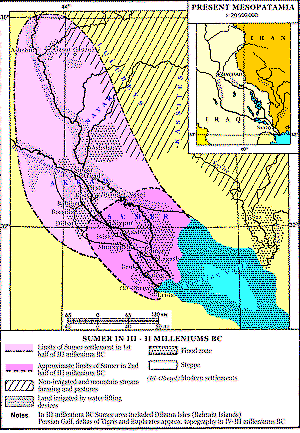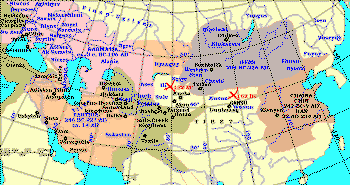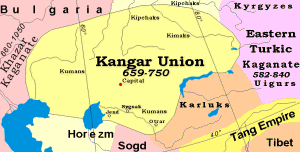Introduction
The name of the tribe Kangly may be also spelled Kankalis or Qanqlis, they are Kangars, Kengeress, and Kangju of annals and inscriptions.
Periodization:
| Afanasiev | 2,500 -1,500 BC | Kurgan Culture, settled or semi-settled, cattle breeding, domesticated sheep, bull and horse, subsistence hunting and fishing |
| Andronov | 1,500 - 1,000 BC | Kurgan Culture, settled and semi-nomadic cattle breeding, domesticated sheep, bull and horse |
| Karasük | 1,000 BC - 500 BC | Kurgan Culture, semi-nomadic, cattle breeding, |
| Tashtyk | 200 BC - 200 AD | Kurgan Culture, nomadic cattle breeding and settled agriculture |
|
Kaunchi |
200 BC - 700 AD | Kurgan Culture, nomadic cattle breeding and settled agriculture - Kangars |
Kangars are known in Mesopotamia from Sumerian times, the endonym of Sumers was Kang, at least the endonym of a certain part of Sumers. The Turkic etymology of the Kang is "ancestor", which may very well explain the Central Asian Kangars, but who was the ancestor of the Sumerian Kangs, and how did they get that appellative? In Chinese annals the first references to Kangars in the form Kangju are associated with the name for Fergana 大宛 Dawan/Davan/Daiuan/Dayuan/Da-yuan/Ta-Yüan/Ta-Yuan, "Great Yuan", literally "Great Ionians", which explains the rectangular layout of the Kaunchi settlements: the archeology so far was digging up the Greek colonies in the Kangar lands, finding Greek and probably mixed and indigenous burials, but missing the much less visible indigenous settlement and accompanying burials. About Kangar/Badjanak graves we know from S.A.Pletneva: Badjanaks buried the horse or its effigy next to the diseased in a wide grave suitable to contain a human and a horse corpses, in a shallower grave.
By the time Kangars reached Europe at about 890 AD, they maybe numbered 500,000 people, 1,200,000 wagons, 30,000,000 cattle, 100,000 cavalry army. A good portion of them remained in situ, joining the ruling powers of the time, or melted away in different directions, leaving their traces on the way.Kaunchi_culture
http://en.wikipedia.org/wiki/Kaunchi_culture
10 May 2011
Typical for the Kaunchi culture are settlements located in proximity to water and surrounded by distinct kurgan burials of catacomb type with long dromoses, crypts, and burial vaults, with bone horse trappings and typical nomadic rites. (Masson V.M., Pre-Islamic Central Asia, http://www.iranica.com/articles/archeology-v ) The people of the Kaunchi culture practiced predominantly cattle husbandry and non-irrigated farming (grain cultures of millet, barley, wheat, and rice, cotton, melons, and fruits).
For the Kaunchi culture are typical hand-modeled pottery: khums (large vessels for water and produce), pots, pitchers, and cups with handles adorned with ram’s head. In the first centuries CE grew the proportion of potter's wheel ceramics. The ram head ornament was replaced by a bull head in the late 3rd c. and early 4th c. At that period in the kurgans also started appearing weaponry (The weaponry, and the absence thereof, can tell a story going back a millennia. The Kaunchies came to the area populated by the late Andronovo people, who were as well nomadic cattlemen and probably their kins remote by 2,000 years, 6,000 km distance, and any intermixes in-between. Kaunchies have traveled across Caucasus, Mesopotamia, Iranian foothills to Central Asia, and who knows where they've been in-between, the Andronovans came directly from the N.Pontic and Urals foothills. The picture needs a lot of anthropological elucidation).
The settlements usually have monumental oval buildings in the center, at times with a defensive wall. A single large 150 hectares settlement was the city of Kang (Kanka) south of Tashkent founded in the first centuries CE with a square layout, encircled by a wall with inner passages. (Masson V.M., Pre-Islamic Central Asia)
The territories with the Kaunchi-type remains spread from the Otrar region along Syrdarya to the south of Tashkent, they were attributed to the domain of the Kangar polity (Ch. 康居 Pin. Kangju) known from the Chinese sources, with the capital Kang. The Kaunchi culture significantly impacted the archeological cultures in the vast territories of the Middle Asia. (Masson V.M., Pre-Islamic Central Asia)
Literature
*Drevnosti Chardary, Alma-Ata, 1968
*Grigoriev G.V., Kaunchi-Tepe (excavations of 1935), Tashkent, 1940
*Isamiddin M.,Suleymanov R.Kh., Yerkurgan (stratigraphy and periodization),
Tashkent, 1984
*Levina L.M. Ceramics of lower and middle Syrdarya//Works of Khorezm Archeological &
Ethnographic Expedition, Vol 17, Moscow, 1971
*The Great Soviet Encyclopedia, 3rd Edition, 1970-1979
References
Translated from The Great Soviet Encyclopedia, 3rd Edition, 1970-1979 http://encyclopedia2.thefreedictionary.com/Kaunchi+Culture
Category:Archaeological cultures
Category:Archaeology of Kazakhstan
Category:Archaeology of Uzbekistan
http://en.wikipedia.org/wiki/Sintashta-Petrovka
 |
Map of the approximate maximal extent of the Andronovo culture. The formative Sintashta-Petrovka culture is shown in darker red. The location of the earliest spoke-wheeled chariot finds is indicated in purple. Adjacent and overlapping cultures (Afanasevo culture, Srubna culture, BMAC) are shown in green. |


